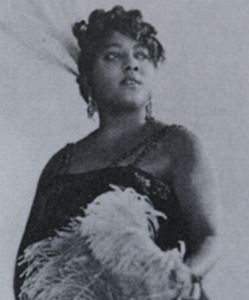Blues Origins
At the end of the first decade of the twentieth century, the term “blues” applied to a new type of song emerging from Black communities in the southern United States. In the wake of White resistance to Black people’s social and economic progress in the form of Jim Crow laws, lynching, institutionalization of racial segregation, and disenfranchisement of Black voters, a new generation of Black people realized their fight for freedom and the American dream was an uphill battle yet to be won. Under these circumstances, blues music expressed the attitudes of Black people and their lives in the United States specifically shining light on new social and sexual encounters they experienced. Black women contributed the most to the early evolution of blues music in mainstream media because of their success in the blues genre while attempting to redefine their image in American society.
Black Women in the Blues
Blues music was always considered a commercial music because it was usually performed with the expectation of a monetary reward. As it became more prevalent in vaudeville theaters, more opportunities for black performers increased. By 1910, reports of blues songs being sung and played by vaudeville entertainers emerged with the twelve-bar and other typical blues strains being detected in some published ragtime piano compositions. In 1912, five songs were copyrighted with the genre “Blues” in their titles and a number of black vaudeville singers became closely identified with the music and rose to stardom like Gertrude “Ma” Rainey and Bessie Smith.

In 1920, vaudeville singer Mamie Smith was the first Black vocalist to record blues music commercially with hits including “That Thing Called Love” and “Crazy Blues”. Smith’s success resulted in the recording of many other vaudeville blues stars throughout the 1920’s, mainly women who were accompanied by a small jazz combo. Black women became extremely popular blues singers and songwriters which facilitated the spread of blues music throughout the United States. Popular and successful Black women blues singers include Bessie Smith, Ida Cox, Clara Smith, Bertha “Chippie” Hill, Rosa Henderson, and Sara Martin. Male blues singers also gained some popularity as solo singers, however they were not as popular as the women and their bands.
Why Black Women Were So Important
Coming into the twentieth century, minstrel shows were extremely popular in mainstream media. These shows which mocked black people involved white people dressing in black face and “typical” Negro fashions to create negative stereotypes about Black people in the U.S. These shows heavily populated mainstream media and created an environment which made Black people’s talents strictly for the entertainment of white people. Black men and women were targeted in minstrelsy but in different aspects, each depicted as servants but black women were depicted as being ugly and unfavorable to any men especially through the caricature “Mammy”.
However, Black women performing Blues music redefined their depiction from being ugly servants for white households to hyper-sexualized creatures adored by all men. In this redefinition, black women amassed great amounts of popularity and success while also providing opportunities for other black musicians to be successful by playing in or managing their bands. Without the role that Black women played in blues music, blues would not have evolved nor been such a success for black people during its early phases. Black women contributed the most to the early evolution of blues music in mainstream media because of their success in the blues genre while attempting to redefine their image in American society.


